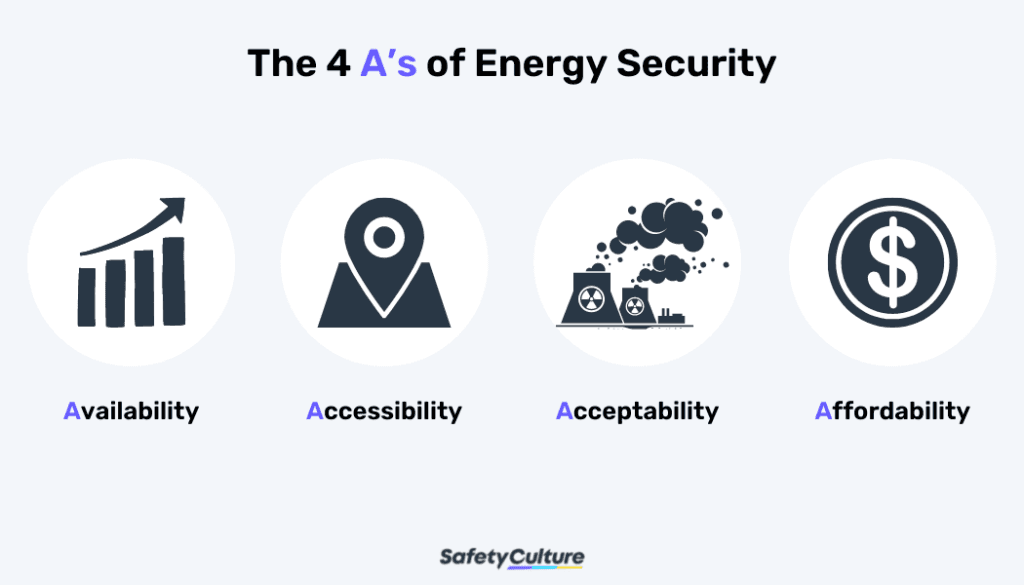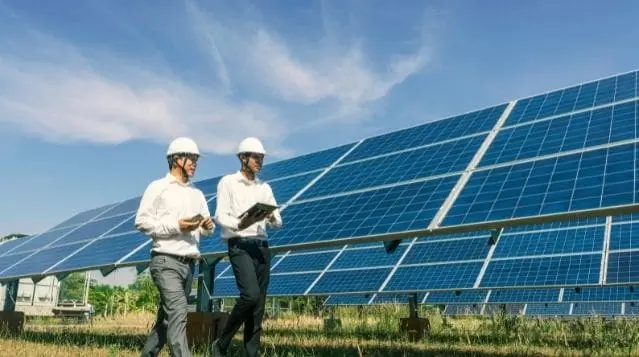What is Energy Security?
Energy security is the capability to establish an efficient, sustainable, and affordable energy system that meets the demands of people’s lives and their daily activities.
Per the International Energy Agency (IEA), energy security has two main aspects: long-term and short-term energy security. The former deals with investments on energy supply and how it connects to timely economic developments and environmental needs. The latter, on the other hand, mainly tackles how the energy system is able to carry out prompt responses to sudden changes in the energy supply and demand cycle.
The energy security definition can vary per country depending on a variety of factors such as:
- location;
- natural resource;
- economic status;
- import and export activities on energy, and its vulnerability to energy supply disruptions;
- political system; and
- international relations.
Having that said, it’s crucial to note that there’s no universally accepted definition of energy security that is bound to surpass the test of time. Hence, the energy security meaning will always depend on the subject, threats, and measures of energy security.
Importance
Access to energy affects the provision and sustainability of humans’ basic needs. Apart from that, it also contributes to a country’s economic growth, political stability, and overall development and security of other sectors such as agriculture and manufacturing.
Another substantial answer to the question “Why is energy security important?” is that it’s one of the 4 pillars of the Association of Southeast Nations (ASEAN) Energy Cooperation in Achieving Sustainable Development. Along with energy accessibility, affordability, and sustainability, energy security forms a significant part in determining sustainable energy planning.
Moreover, energy security is tied to food security and food transportation, in a way that the agricultural sector is both an energy user and energy generator. Further, food production covers about 70% of water consumption and 6% of energy consumption on a global scale.
The rapid growth of energy demand brought about by economic expansion, population growth, new energy uses, and income growth makes energy security a pressing concern. This is why countries make it a goal to ensure that their economies will function without disruptions in energy supply, providing people with adequate, reliable, and affordable supplies of modern and clean energy.
Factors Affecting Energy Security
Global energy supply, being unevenly distributed, is affected by various factors. These include:
- Physical factors – Regions that have a predominantly sedimentary geological makeup presumably possess more available fossil fuels than other regions.
- Costs – Depletion of non-renewable energy resources result in highly expensive extraction processes. Hence, exploitation of such resources only becomes viable when the demand increases, as this often results in rising energy prices needed to support extraction and production costs.
- Technology – Technological advancements gave rise to the exploitation of new energy sources. Technology, though there’s a high risk of posing threats to the environment, helps make renewable energy more economically viable and productive.
- Political factors – Socio-political issues such as international conflicts have a high potential to disrupt energy supply and destroy energy sources, making it challenging to maintain energy security.
What is Energy Insecurity?
What is energy security and insecurity? In contrast to energy security, energy insecurity is what countries experience when there is an interruption to the availability of energy sources and/or energy is unaffordable. Energy insecurity can bring about a variety of problems, including the following dimensions:
- Economic energy insecurity – High energy costs mean major financial burden most especially to low-income households.
- Physical energy insecurity – Deficiencies within the physical infrastructure like faulty heating and cooling systems and poor lighting can impact thermal comfort, cause harmful exposures, and increase energy costs.
- Behavioral energy insecurity – Negative strategies used to deal with the impacts of economic and physical energy insecurity pose risks to health, safety, and even residential stability.
These dimensions then cause a number of adverse environmental, health, and social consequences. Harmful environmental exposures (gas leaks, mold, and humidity), as well as a lack of acceptable residential temperatures, can aggravate asthma symptoms, particularly during the winter months.
Components of Energy Security

The 4 A’s of Energy Security | SafetyCulture
Now, what are the components of energy security? In order to fully understand what constitutes the very meaning of energy security, it’s necessary to go through its 4 A’s: availability, accessibility, acceptability, and affordability.
Availability
With oil being one of the world’s major energy sources, the growing dependence on oil along with the high prices tied with it become one of the most crucial challenges on energy security. The ever-increasing demand for energy might be disproportionate to the amount of oil in the world. Hence, having substitute sources of energy is detrimental to sustaining global consumption.
Accessibility
There are economic and geopolitical factors along with technological advancements that serve as barriers to energy supply becoming accessible. These barriers include the following:
- Uneven distribution of global oil resources
- Locations of undiscovered resources are in very deep or arctic areas
- Shortage of adept workers in the oil and gas industry
- More expensive development and production of non-conventional oil
With these, meeting future demand growth poses challenges to energy security.
Acceptability
The demand for energy tends to contribute to the increase in energy-related impacts to the environment. Hence, policymakers worldwide attempt to combat such impacts including pollution through strict implementation of environmental regulations toward energy security.
Affordability
With oil prices having a high degree of volatility due to geopolitical issues, supply disruptions and supply-demand imbalances result in inevitable oil price hikes. For this instance, investing in the oil sector during periods of high oil price is highly encouraged to enable oil supply and price stability.
Measures
Having standard methods in place to use in measuring a country’s energy security risk index helps set the proper context on how to avoid energy insecurity in the long run.
The International Energy Security Risk Index is an energy risk indicator that identifies policies and other factors that affect international energy security. This is done by using quantifiable data, historical data trends, and government projections. On the Global Energy Institute’s website, a legend is also used to show the various quartiles representing the degree of energy security risk scores that each of the top 75 energy-consuming countries has. Those belonging to the first quartile have the lowest risk and those with the highest risk are grouped under the fourth quartile.
Meanwhile, the World Energy Council’s Energy Trilemma Index tool aims to rank countries based on their ability to provide sustainable energy based on 3 dimensions: energy security, energy equity, and environmental sustainability. Ultimately, this index tool measures overall performance toward a mix of national energy policies and their viability.
Strategies
As the energy sector strives to adapt toward sustainability, meet the growing energy demand, and brace for the digital world, new security-related challenges are bound to emerge. For this reason, countries, companies, or states must take action and implement strategies that tackle long-term energy security efforts.
Here are some recommendations to achieve energy security.
Risk management
To improve the energy security situation, risk management is key. This process involves eliminating risks by diversifying energy sources, absorbing risks by creating a reserve margin of power generation capacities, and preparing for inevitable supply disruptions by creating strategic reserves.
Create Your Own Energy Risk Management Checklist
Eliminate manual tasks and streamline your operations.
Get started for FREEDiversification
Reducing exclusive dependence on just a few energy sources or providers leads to diversification and introduction to sustainable alternatives. This strategy gives way for regions, countries, and states to shield themselves from energy disruptions and further reinforce energy security.
They can also consider switching suppliers to lessen dependence on imports. Exploitation of their own resources and using alternative energy sources (such as cleaner solar and wind energy) are some ways to achieve full self-sufficiency.
Policies and laws
The Energy Independence and Security Act of 2007, as signed by former President George W. Bush, was set forth to improve United States’ energy security by:
- increasing the production of clean renewable fuels and other alternative fuel sources;
- promoting research on and deploying greenhouse gas (GHG) capture and storage technologies;
- improving the energy performance of the Federal Government; and
- improving vehicle fuel economy, among others.
On the other hand, the American Clean Energy and Security Act of 2009 is mainly focused on promoting a clean energy economy, with the following provisions:
- Creating a combination of energy efficiency and renewable electricity standard
- Aiming and strategizing for the improvement of the overall US energy productivity and maintaining the improvement rate through 2030
- Building a cap-and-trade system for greenhouse gas emissions and quantifying goals on emissions reduction
While certain policies and laws are set in place to help lead a nation to sustainable, long-term energy security, responsible strategies that are set forth in these two acts contribute largely to reducing carbon footprint by reinforcing a cleaner energy economy.
Guarantee Energy Security with Lockout Tagout Training
Workers who handle hazardous materials and energy are exposed to a variety of risks, from potential health issues to more serious physical dangers brought on by malfunctioning equipment, stored energy, leaking chemicals, or toxic gas in the workplace.
To guarantee that your employees can operate safely and control possible hazards, it is your duty as an employer to adhere to your state’s safety rules and give them thorough lockout tag out training using the SafetyCulture platform.
Thanks to this training, your employees will gain knowledge of how to:
- mark and tag equipment;
- isolate dangerous energy or substances;
- shut down equipment; and
- release stored energy through this process.
They’ll also be guided through specialist subjects including device removal, group lockout, shift changes, energy control devices, and tag out allowances in some of the training courses for lockout tagout.




